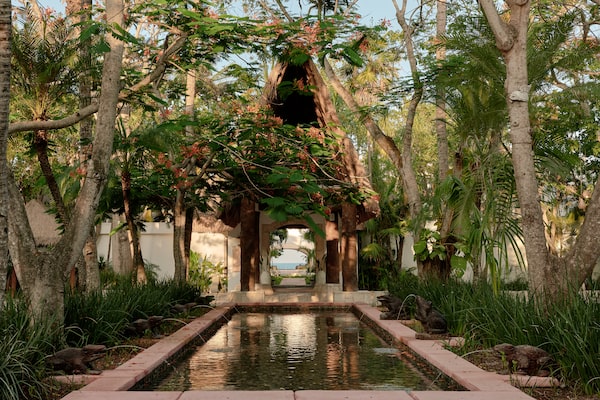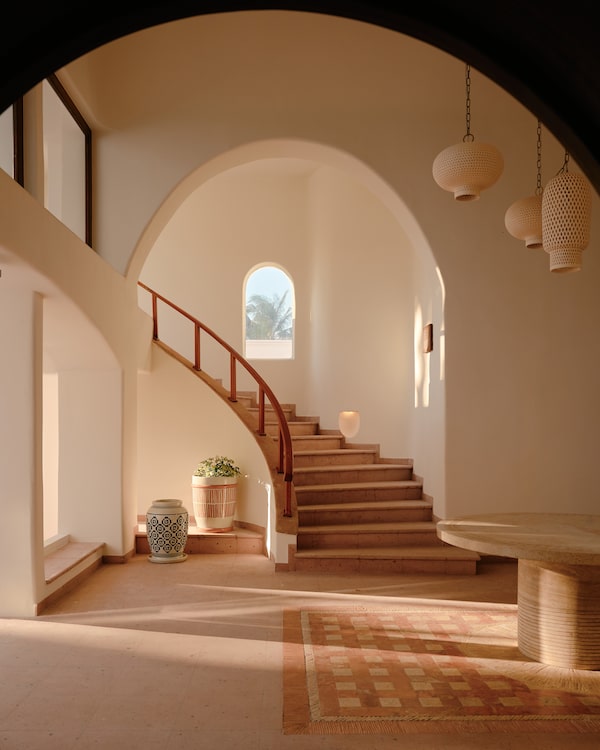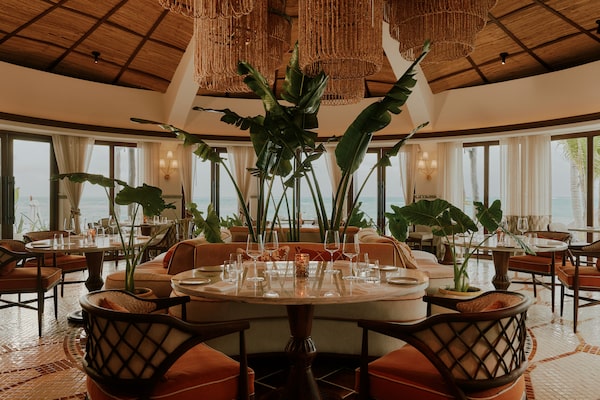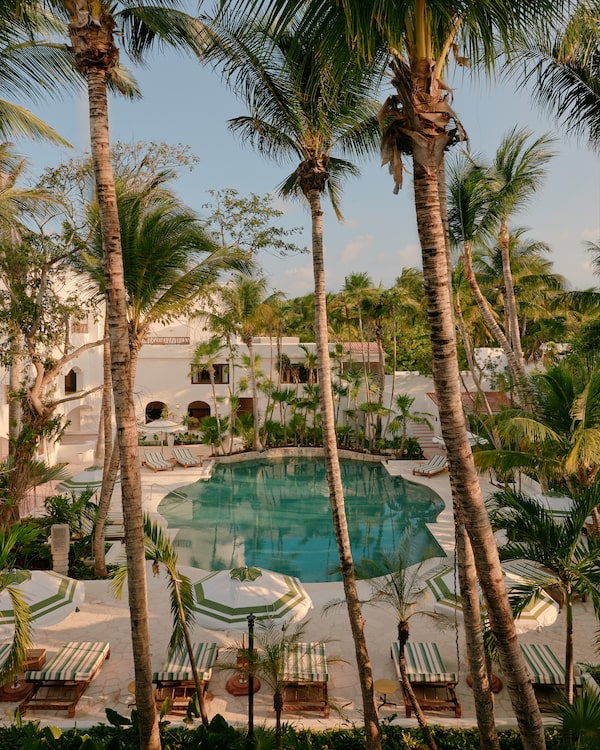
Maroma, a Belmond resort on the Mayan Riviera, reopened in August 2023 after a renovation spanning two years, with new emphasis on Mexican culture, gastronomy and design.Belmond
Steering through verdant jungle in a tropical downpour, our Cadillac Escalade passes signs for wild pigs, spider monkeys and coati, the raccoon’s mischievous Mexican cousin.
The tangle of jungle opens to a stone courtyard, a cluster of white stucco houses, the Atlantic crashing beyond.
Stepping out to a humid mist, we spot a tiny thatched hut on the ground. It’s a shrine to the aluxes, mythological Mayan sprites who stand knee-high and watch over the land, taking offerings of honey, coins and mezcal in return.
We enter an open-air lobby, fragrant with the smoke of copal, a tree resin burned in purification rituals throughout Mesoamerica. A woman greets us, frosty margarita in hand.
The welcome epitomizes Maroma, a Belmond resort on the Mayan Riviera reopened in August, 2023, after a renovation spanning two years, with new emphasis on Mexican culture, gastronomy and design. And decadence, so much decadence.
Secluded on 200 acres of jungle, Maroma’s 72 rooms, suites and villas are low-slung and discreet. Each was reimagined by chic London designer Tara Bernerd, who worked with Mexican artists, pottery and textile makers, producing radiant spaces with a fine eye for detail. Like the 700,000 hand-painted clay tiles adorning the property, made by José Noé Suro’s leading ceramic studio in Mexico. And the plaques marking each guest room: the playful imagery – mermaids, parrots, flowering cactuses – comes from Lotería, Mexican bingo.

Secluded on 200 acres of jungle, Maroma’s 72 rooms, suites and villas were reimagined by chic London designer Tara Bernerd, who worked with local artists, pottery and textile makers.Belmond
There are many thoughtful, artful touches inside this oasis. They feel a world away from the rest of this stretch south of Cancún, overdeveloped for decades, high-rise megaresorts crowding the beachfront, tourists gorging themselves at all-inclusives. These are the “sanitized bubbles” of beach tourism author Sarah Stodola described in her 2022 book The Last Resort: A Chronicle of Paradise, Profit, and Peril at the Beach. They’re familiar formulas that keep visitors comfortable, and have little to do with the world beyond resorts’ walls.
Which is why Maroma, though a gated, luxury bubble itself, scores points for insisting on something more culturally relevant, on regional food, ritual and habitat – part of a broader shift sweeping high-end tourism.
Over four days, I’ll be living my alternate life in a sumptuous apartment overlooking the hotel’s quiet, leafy courtyard.
On arrival, a welcome snack awaits under a glass bell jar, Alice in Wonderland-like. There is limey guacamole, a carafe of tequila, and plump, roasted crickets resting on a bright leaf: “Eat me,” the crickets challenge; they’re smoky, crunchy.
In the closet, a bohemian ensemble for roaming the grounds: woven sandals, a translucent caftan embroidered by women in Chiapas. “Have the hotel run you a bath,” suggests another writer on this press trip, whose specialty is luxury travel.
The first night, I fall asleep easily, a curtain of palms swaying outside the window. I feel like the “special chosen baby child of the hotel,” as Armond, the resort manager in HBO’s The White Lotus, describes his guests in Maui.
In the morning, Maroma’s well-to-do guests emerge. There are beachside runs and sunrise salutations, personal training at the gym, green slurries of chlorophyll and chaya, Mexican tree spinach.
Me, I work on a breakfast burrito the size of a log at Casa Mayor. The restaurant’s sun-dappled, its windows flung open, waves lashing the shore. Well-preserved baby boomers float in, couples at various stages in their marriages, easy in linen shirts, familiar with luxury (the nightly starting rate is CAD $1,473). Everyone looks dewy and relaxed.

At Woodend, the open-fire restaurant, enjoy dishes such as grilled Sinaloa blue prawns with daikon, basil and green mango.Belmond
Attending to us, a small army of servers outfitted in sage and sandy tunics and slacks made from manta, a Mexican cotton cloth.
Chef Daniel Camacho updates regional Mexican cuisine. For our first dinner, there is roasted red octopus with soy, lemon and white cucumber, and later, chamomile-scented tres leches cake. Camacho’s sauces are addictive – a green pop of tomatillo; the murky black of grilled habanero, salty and fragrant with lime.
Under a thatched roof is Freddy’s Bar, the beach hangout. Over lunch one day, I have tiraditos: tuna studded with serrano chilies, cilantro, mango, cucumber and Melipona bee honey.
With the reopening, Michelin star chef Curtis Stone joins with the open-fire restaurant Woodend, where we have our final feast, including grilled Sinaloa blue prawns with daikon, basil and green mango.
We delve further into local gastronomy over a series of the hotel’s workshops. We learn about nixtamalization, the soaking and cooking of corn in lime water. We make tortillas and pozol, a thirst quencher sustaining workers through sweltering days here.
Ximena Moreno, the mixologist behind smoky cocktails at Bambuca, Maroma’s bar, leads us on a “Journey Around the Agave.” Knowledgeable and patient with her very merry students, Moreno steers clear of tequila shots, focusing on mezcal and lesser-known libations like raicilla, sotol and pulque. We snack on blackened corn and roasted agave worms (honey and salami, the tasting note on that last one). There are tales of Filipino seamen bringing their moonshine skills to these shores, and distillers dodging taxes by labelling the agave a root, not a plant. The finer points get lost in the fog.
But my mind was already pleasantly vacant before Mezcal-palooza, thanks to an opulent, two-hour treatment at the Maroma Spa by Guerlain, officially opened to guests in January. Masseur Juan Carlos’ hands are a tornado; I emerge slick as a seal.
The hotel’s menu of “experiences” goes heavy on the wellness-speak. An under-the-sea-wave meditation guides “the human spirit through various stages of consciousness.” A cacao ritual “helps increase the energetic field of our hearts.” (Whatever happened to the age-old mantra of beach resorts? “Shots! Shots! Shots!”)
For wanderers, the hotel offers daytrips to archeological sites at Tulum and Ek’ Balam; swims in cavernous, turquoise cenotes, and sustainable ocean golf, with biodegradable balls that turn into fish food once they’re launched into the Caribbean Sea.

The hotel’s menu of 'experiences' goes heavy on the wellness-speak.Belmond
Sustainability is the buzzword at Maroma. The spot was a coconut plantation when Mexico City architect Jose Luis Moreno flew over in 1976. Moreno bought the land, opening a hotel in 1995. Belmond’s overhaul has amplified ecological preservation. A nursery counts 2,000 endemic plants and trees; there’s a sea turtle sanctuary; a bird conservation program and hive expansion project for the Melipona bee, stingless and endangered.
Mid-trip, I leave the hotel grounds, walking miles of beach in blustery winds. Slowly, the sand bar narrows, completely eroded in places. One resort after another fills the strip – drab concrete blocks, their faded logos lodged in the sand. There are more tourists bobbing in the waves here. Plastic belches up from the ocean – a stray flip flop here, an old toilet brush there.
Out further, an abandoned resort juts out from the jungle, its lobby a gaping maw, wooden umbrellas disintegrated, the beach overtaken by seaweed and vines. Security guards keep watch over the ruins, which locals report was left to rot after Hurricane Wilma pounded the Yucatán Peninsula in 2005.
It’s a rupture in the paradise fantasy. I think back to the aluxes, the miniature keepers of land in Mayan lore. If disrespected, they play tricks on humans, wreaking havoc on their lives.
I walk back to the pristine, white sands of Maroma. The resort’s marketing makes little mention of this beach; it’s like an afterthought. This approach feels different. By rejecting unchecked development, de-emphasizing tourist wants like the beach, and turning back to local stories, Maroma moves the resort experience forward.
The writer was a guest of Maroma, A Belmond Hotel. It did not review or approve the story before publication.
 Zosia Bielski
Zosia Bielski